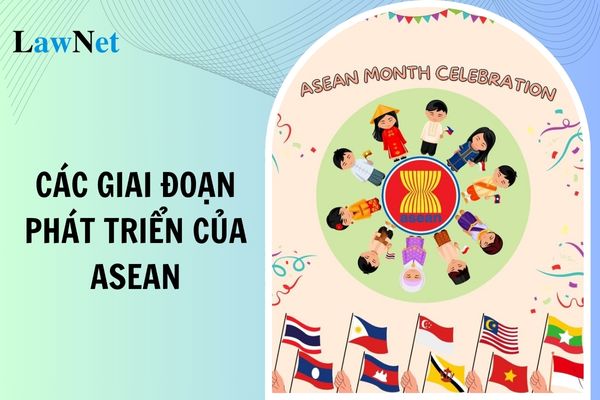Vietnam: What are the developmental stages of ASEAN from 1967 to the present? What does the knowledge about ASEAN covered by the 12th-grade History curriculum include?
What are What are the developmental stages of ASEAN from 1967 to the present?
Since 1967, the developmental stages of ASEAN include five stages. Specifically, What are the developmental stages of ASEAN from 1967 to the present are as follows:
1. Formation and Goal Setting Stage (1967 - 1975)
- ASEAN was established on August 8, 1967, in Bangkok, Thailand with five founding members: Indonesia, Malaysia, the Philippines, Singapore, and Thailand.
- These countries jointly signed the Bangkok Declaration, identifying the goal of ASEAN to promote economic, social, and cultural cooperation, while ensuring peace and stability in the region.
2. Member Expansion and Enhanced Cooperation Stage (1976 - 1984)
- In 1976, ASEAN held its first ASEAN Summit in Bali, Indonesia. Here, member nations signed the Treaty of Amity and Cooperation (TAC), committing to peacefully resolve regional disputes.
- In 1984, Brunei joined ASEAN on January 7, becoming the sixth member and marking the first time ASEAN expanded beyond the five founding countries.
3. Comprehensive Cooperation and Promoting Regional Peace Stage (1985 - 1998)
- ASEAN played an important role in promoting regional peace, particularly through supporting dialogue for conflict resolution in Cambodia in the late 1980s.
- During this period, ASEAN continued to expand its membership:
+ Vietnam joined on July 28, 1995, becoming the seventh member.
+ Laos and Myanmar joined on July 23, 1997, bringing the total membership to nine.
+ Cambodia joined on April 30, 1999, completing the enrollment of Southeast Asian nations and bringing ASEAN’s total membership to ten.
4. Building the ASEAN Community Stage (1999 - 2015)
- In 2003, ASEAN adopted the Bali Concord II Declaration, aiming to establish an ASEAN Community by 2020, later moved up to 2015. The ASEAN Community comprises three main pillars: the ASEAN Political-Security Community, the ASEAN Economic Community (AEC), and the ASEAN Socio-Cultural Community.
- In 2007, ASEAN adopted the ASEAN Charter, marking a new development as ASEAN became an intergovernmental organization with a clear legal and institutional framework.
5. Consolidation and Sustainable Development Stage (2015 - Present)
- On December 31, 2015, the ASEAN Community was officially established, marking a close-knit integration among member countries and enhancing regional cooperation.
- Since 2016, ASEAN has focused on sustainable development goals and strengthened international cooperation with major partners such as China, Japan, South Korea, India, and the United States. Agreements like the Regional Comprehensive Economic Partnership (RCEP) have helped ASEAN expand economic cooperation and consolidate its international position.

What are the developmental stages of ASEAN from 1967 to the present? What does the knowledge about ASEAN covered by the 12th-grade History curriculum in Vietnam include? (Image from the Internet)
What does the knowledge about ASEAN covered by the 12th-grade History curriculum in Vietnam include?
Under the General Education Program for History issued with Circular 32/2018/TT-BGDDT, the knowledge about ASEAN covered by the 12th-grade History curriculum in Vietnam includes:
The Birth and Development of the Association of Southeast Asian Nations (ASEAN)
Formation Process of ASEAN
- The formation process of ASEAN
- Purpose of ASEAN's establishment
ASEAN's Development Journey
- From ASEAN 5 (1967) to ASEAN 10 (1999)
- Main stages of ASEAN's development (1967 to present)
Organizational Structure of ASEAN (presented in diagram form)
- ASEAN Summit
- ASEAN Coordinating Council
- ASEAN Community Councils
- Sectoral Ministerial Meetings
- ASEAN Secretary-General and ASEAN Secretariat
- National ASEAN Secretariat
Basic Principles and Operating Procedures of ASEAN
- Basic principles (according to the ASEAN Charter)
- ASEAN's decision-making procedures
ASEAN Community: From Idea to Reality
Idea and Plan to Build the ASEAN Community
- Idea to build the ASEAN Community
- Objective to build the ASEAN Community
- Plan to build the ASEAN Community
Three Pillars of the ASEAN Community
- ASEAN Political-Security Community (APSC)
- ASEAN Economic Community (AEC)
- ASEAN Socio-Cultural Community (ASCC)
ASEAN Community Post-2015
- ASEAN's vision post-2015
- Challenges and prospects of the ASEAN Community
In Vietnam, what academic topics does the 12th-grade History curriculum include?
According to the General Education Program for History issued with Circular 32/2018/TT-BGDDT, the time allocated for academic topics is 35 lessons. The projected number of lessons for academic topics (including tests and evaluations) is as follows:
| Content | Grade 10 | Grade 11 | Grade 12 |
| CAREER ORIENTATION TOPICS | |||
| Topic 10.1: Fields of History | 10 | ||
| PRACTICAL EXPERIENCE ACTIVITIES TOPICS | |||
| Topic 10.2: Conservation and Promotion of Cultural Heritage Values in Vietnam | 15 | ||
| Topic 11.1: History of Traditional Vietnamese Arts | 15 | ||
| Topic 12.1: History of Folk Beliefs and Religions in Vietnam | 15 | ||
| KNOWLEDGE ENHANCEMENT TOPICS | |||
| Topic 10.3: The State and Vietnamese Law in History | 10 | ||
| Topic 11.2: War and Peace in the 20th Century | 10 | ||
| Topic 11.3: Historical Figures in Vietnamese History | 10 | ||
| Topic 12.2: Japan: Historical Journey from 1945 to Present | 10 | ||
| Topic 12.3: Vietnam's International Integration Process | 10 |
Thus, the academic topics in the 12th-grade History curriculum include:
- Topic 12.1: History of Folk Beliefs and Religions in Vietnam
- Topic 12.2: Japan: Historical Journey from 1945 to Present
- Topic 12.3: Vietnam's International Integration Process

